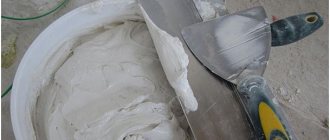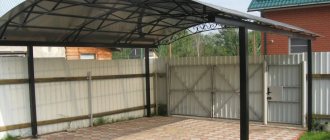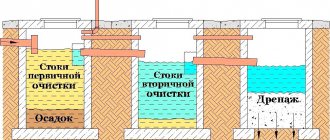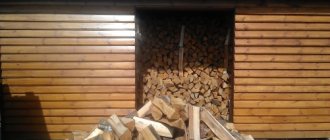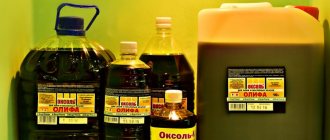A storage septic tank for a dacha consists of barrels made of various materials: you can buy kunas, a metal tank or cistern, as well as a reinforced concrete container, but all of them have a mandatory condition - tightness.
Storage septic tank for sewerage.
Large waste containers are made of steel or fiberglass, small ones are made of polypropylene or HDPE (low-density polyethylene. The quality of materials is decisive for durability. Imported Chinese steel quickly rusts, while German polypropylene has significantly better strength characteristics than cheap Chinese or domestic analogues.
For containers without stiffeners, the wall thickness is important. Insufficient thickness leads to deformation, compression and destruction of the container by the soil. The greater the depth, the stronger the material should be. In addition, additional reinforcement may be required, for example, using a sand-cement mixture.
A septic tank is installed when other options are impossible. For example, the object is located in a sanitary zone (100 m from a river or lake) and the discharge of any wastewater is prohibited. Vodokanal requires the installation of a septic tank and the mandatory conclusion of an agreement for sewerage services.
Sometimes users do not adequately estimate their water consumption, so they are sure that a container with a volume of 3-5 m3 will require 1-2 pumpings per year. This is possible if the only plumbing equipment in the house is a hanging washbasin, which is filled from a bucket and drained up to 10 l/day (the volume of the toilet tank), or the family lives on site for about a week a year. In reality, a permanent resident uses about 0.2 m3 (200 liters) of water per day, so a family of 5 people will fill a 3 m3 container within 3 days.
In order not to call a sewage disposal truck every 3 days, a large-volume storage tank is installed, but this requires the possibility of passage of appropriate vehicles and a truck crane.
Because If the groundwater level is high, an empty or half-empty container will float up like a submarine without ballast, then it must be attached to a concrete slab, which leads to a significant increase in installation costs.
Photo. Storage septic tank
Catalog of storage tanks
Advantages of storage septic tanks
Despite their simplicity, storage septic tanks for a country house have a number of advantages:
- the simplest device;
- reliability;
- autonomy;
- possibility of installation at high groundwater levels;
- tightness;
- corrosion resistance;
- compactness (models with a vertical layout).
Among other things, prices for storage-type septic tanks are significantly lower than for more complex sewerage equipment. Installation and maintenance do not require the involvement of appropriate specialists.
Rules for installing autonomous sewers
Local sewerage is a system that can potentially pose a threat to the environment and ecological situation of the region. You can’t just spontaneously build a treatment facility. It is necessary to first develop project documentation, approve it with the SES authorities, obtain permission, and only after that begin purchasing materials and starting construction work. During the installation of sewerage, you should adhere to the norms and rules regulated by SNiP and SanPiN. When choosing a septic tank location on the territory, it is very important to take into account the recommended distance from the tank to various objects:
- to the house - at least 5 m;
- to artificial or natural reservoirs - at least 30 m;
- to reservoirs with running water – from 10 m;
- between sources of drinking water and sewage tanks, the distance is at least 50 m;
- to trees – 3 m, to bushes – 1 m;
- to the road – 5 m;
- to the gas pipeline running underground – 5 m.
You must strictly adhere to the installation instructions and perform technological processes carefully and carefully. The performance characteristics and service life of sewer systems depend on the quality of the container for the septic tank, as well as on how competently the installation work is performed. Typical mistakes that are made in the process of arranging a septic tank: poor sealing of joints, incorrect installation of pipes, as a result of which there is no overflow from one compartment to another.
There are enough varieties of septic tanks today. You can buy a ready-made structure and install it on the territory of your home quickly and without much effort. And you can save money by spending time on arranging an autonomous sewer system from scrap materials. What to do? The choice is yours. The main thing is that the septic tank is built in compliance with all norms and requirements, does not harm the environment, and properly performs its functions for a long period.
Choosing a storage septic tank for a summer residence
When choosing a storage-type septic tank for a summer residence, it is enough to focus on only three criteria:
- Layout.
- Material.
- Volume.
According to their layout, sewer tanks can be horizontal or vertical. The first type should be chosen in cases where it may be difficult to deepen a pit on a site due to high groundwater level. Vertical septic tanks are more compact, can be located at a great distance from the house, but are more prone to being pushed out of the ground. Therefore, when installing them, anchoring is used - the container is rigidly fixed on a concrete slab laid or formed at the bottom of the pit.
Based on the material, fiberglass septic tanks are most often found. Unlike polypropylene, they are more durable and reliable. In addition, such products are immune to household chemicals and corrosion.
Choosing the volume of a storage septic tank is one of the most difficult moments. It all depends on the intensity with which the house’s sewage system will be used. For example, if this is a permanent home for a family of three, then with an average daily water consumption of 100 liters per person, a 16-cube container will be filled to the top in just 2-3 months.
It is for this reason that storage septic tanks are preferred when arranging sewage systems in dachas, where water flow is not so intense. In such cases, it is best to select a container with a volume that will be a multiple of the capacity of a standard sewer truck. It would be a good idea to first ask the local utility service what kind of equipment they have. As a rule, in small villages these are sewer trucks with a barrel of 8 cubic meters.
Today there are quite a lot of manufacturers of storage-type septic tanks, which also somewhat complicates the choice of the most suitable option. As an example, our company recommends paying attention to Termite brand products.
Kinds
A storage tank is a well designed for settling and accumulating waste liquids from the sewer system. The main purpose of this reservoir is not just to accumulate wastewater, but to protect the environment from pollution by it.
The classification is made according to the materials from which the well is made and the container. Storage tanks for organizing sewage systems are made of plastic, concrete and metal. Plastic ones are the most convenient to use and easiest to install. They are light, durable, and not damaged by water, but they do have some disadvantages.
Photo: plastic storage
In particular, plastic can be deformed under the influence of earth pressure. To avoid this, they are installed either in a pre-prepared pit with fixed walls, or placed in a metal casing (mesh of reinforcement).
There are such reservoirs:
- Made from PVC. The most common and accessible. On average, they have a wall thickness of up to 4 centimeters, are light, durable, and flexible;
- Fiberglass. Reinforced with fiberglass, they withstand exposure to water and temperature changes, but are destroyed by direct sunlight.
The concrete well is a standard drainage pit. It is very rarely drained for further use. Mostly such storage devices are located underground. They are:
- Open. No bottom. In this case, some of the liquid simply goes into the soil;
- Closed. They have a bottom and require periodic pumping of wastewater.
Ideal for organizing the work of a storm or drainage system, they are very easy to equip with your own hands. There are two installation options: buy a ready-made concrete container or dig a pit, make formwork in it and fill the container over it. They can be made from reinforced concrete rings and square shapes. One of the main disadvantages of concrete storage tanks is their limited service life - they begin to deteriorate after only 10 years of use (for comparison, plastic lasts up to 50).
Concrete storage model
Metal tanks must be additionally protected from corrosion with special paints or enamels. They are considered more convenient than concrete ones, but less practical than plastic ones. In particular, they cannot be installed without additional help.
Photo: metal storage
Also, containers can be of different types of arrangement. They can be installed vertically or horizontally. A vertical wastewater container is used in narrow-shaped areas where it is not possible to prepare a large pit for a storage tank. Horizontal ones are standard and are used on any possible types of plots.
Design and selection criteria
The cast tank is divided into 2 – 3 sectors.
There is a blocker between them. With its help, an airless space is provided for complete cleaning. The first sector is where sewage comes in and settles. Then small particles remain.
The second is the processing of chemical composition with their decomposition.
Third, the remaining elements are separated through gravitational forces. Clarified wastewater is discharged via drainage.
In order to correctly calculate the required size of the septic tank, determine:
- body dimensions;
- daily volume held by the storage device;
- volume of water per family member;
- number of people living in the house.
Length, width, height are the three main parameters by which the body is evaluated. Pipes, hatches, and adjacent structures are taken into account.
To calculate the volume per person, it is better to use a standard table with average values.
What are the advantages of storage capacity?
- The most economical solution for external sewerage in construction.
- Energy independence: wastewater moves by gravity.
- A very simple design, which determines the durability of such a structure.
- The storage tank can be used for both permanent and temporary or seasonal residence.
- Using a storage tank, you can dispose of almost any waste from the inhabitants of the house, including the remains of vegetables, fruits, spoiled food, pet hair, etc.
- Wastewater in a sealed container does not come into contact with the ground in any way, and therefore is guaranteed not to harm the environment.
Popular manufacturers
Linear series Eurolos eco
- the right choice
Storage septic tanks for the dachas of this manufacturer are a local treatment station. There are models that serve homes of three to ten people. Specifications:
- productivity – 0.6 m³/day;
- productivity - 2.4 m³ / day.
Dimensions 0.6 – 1200 x 1500 x 1000 Dimensions 12 – 2100 x 3000 x 1450
The operating principle is simple. Inside there are a mechanical, biological, and post-treatment unit, which are interconnected. Ensures uniform circulation. Autonomous septic tanks do not require electricity.
The material of manufacture is polypropylene, using seamless technology. The device does not require additional insulation in winter, and regular sewage disposal equipment is not required.
Septic tank Termite
A voluminous representative of the septic tank line, designed for up to 10 people. It is necessary if it is impossible to drain wastewater outside at a summer cottage. Equipped with horizontal and vertical struts. They prevent soil pressure and securely hold the structure in the ground.
It is recommended to pump out this model once every three years.
Capacity - 5.5 liters Dimensions, including lid - 2420 x 1670 x 2395 mm.
Thermite storage tanks are made of primary, durable material. Resistant to shock loads. Linear propylene does not react with biological particles. Insoluble in liquids below 60 °C.
The product has passed hydrodynamic tests.
Ergobox
Designed for collection and cleaning of household and household needs. The principle of operation is based on gravitational settling of the liquid. The model is selected based on the number of users. There is a powerful device that can serve up to ten people.
Dimensions: 2010 x 1290 x 1970. Capacity: 1900 liters.
Consumption of one and a half kilowatts per day. Service life up to fifty years.
Equipment:
- station;
- controlled unit: moisture-proof socket, compressor with lock;
- aeration element;
- cable entry fitting;
- reinforced hose with a diameter of twenty millimeters and six millimeters;
- clamps 25 – 30 mm.
Particulate matter removal is carried out at least once a year. To completely pump out, fill the container with water and clean the air filter.
At the dacha, it is permissible to dump kitchen waste, toilet paper, and washing powders into it. Avoid contact with construction waste, various films, acids, alkalis, and cigarette packs.
Purified water can be reused for watering plants during the summer season. Suitable for non-permanent living.
The advantage of the model range is ease of maintenance, silent operation, and elimination of unpleasant odors. The device continues to operate after a power outage.
Features of installation and operation of sewer tanks
When choosing a place to install a container, it is necessary to take into account the gravity drainage of wastewater - if the site is located on a slope, then it should be located below the level of the house.
The bottom of the pit must be smooth and strong, preventing the possibility of the container moving so that the tightness of the connection with the sewer pipe is not compromised.
To anchor the container, use a reinforced concrete slab laid at the bottom of the pit with the obligatory arrangement of a cushion of crushed stone and sand.
To reduce the buoyancy forces of heaving, a pit is dug larger than the dimensions of the container, and the sinuses are filled with a mixture of sand and excavated soil or sand and crushed stone.

